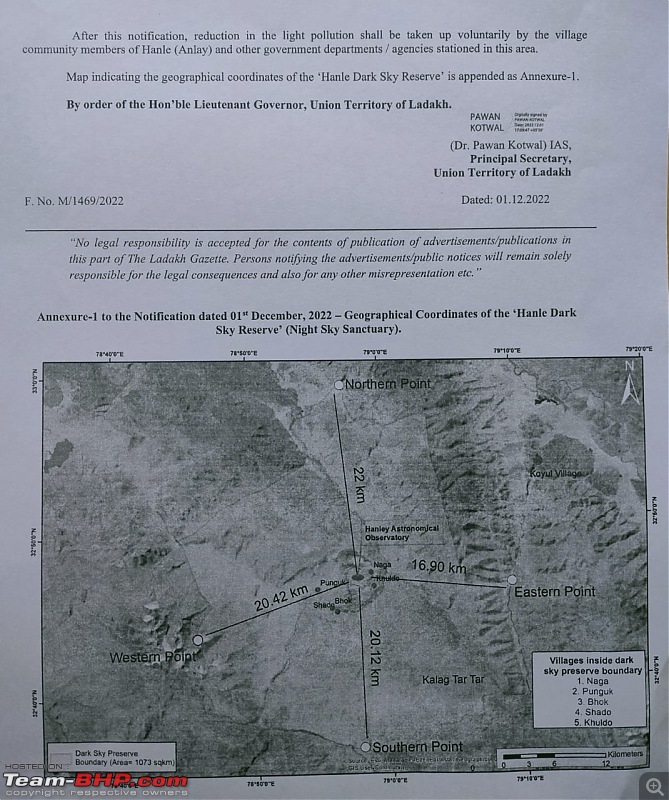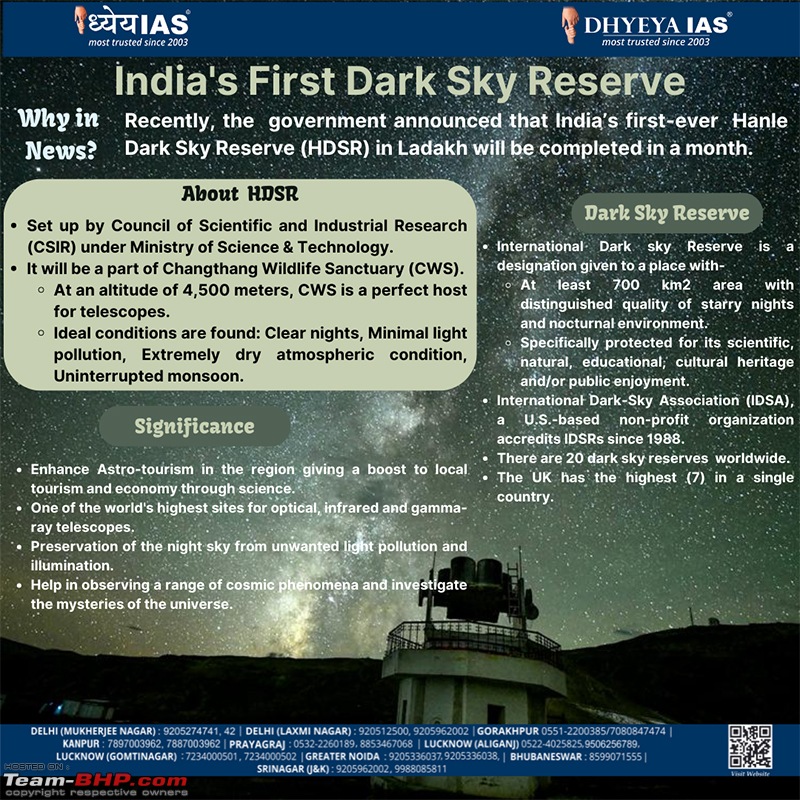On December 01, 2022, the Government of India notified Hanle as India’s first dark sky reserve. 
Source:
https://science.newsbharati.com/Ency...in-Ladakh.html 

Source: DIPR Leh, Twitter.
Dark Sky Reserve
A Dark Sky Reserve refers to an area designated as free from light pollution. It’s a public or private land possessing an exceptional or distinguished quality of starry nights and nocturnal environment that is specifically protected for its scientific, natural, educational, cultural, heritage and/or public enjoyment [IDA-International Dark-Sky Association].
These Areas are typically found in remote locations, away from city lights. The International Dark Sky Association (IDA) works to designate these special places around the world. There are many benefits to having a dark sky reserve. One of the most important is that it protects nocturnal animals who rely on darkness to hunt and forage. Artificial light can also disrupt the natural migration patterns of some animals. In addition, dark skies are necessary for stargazing and astronomical research. The IDA has designated several dark sky reserves in the United States, including Great Basin National Park in Nevada and Big Bend National Park in Texas. To be designated as a reserve, an area must have very little artificial light pollution and must offer public educational programming about the importance of protecting dark skies.
Globally, there are only 20 such certified reserves and 16 sanctuaries, with most of them being located in europe.
Hanle Dark Sky reserve

Source:
https://www.dhyeyaias.com/current-af...rk-sky-reserve
A portion of Changthang Wildlife Sanctuary in Hanle, Ladakh, is earmarked to become the first Dark Sky Reserve in India. The facility will also encourage astronomy tourism, providing a scientific boost to local tourism. Ladakh has considerable potential for conducting undisturbed astronomical observations, which is why it was chosen as the venue for the programme. Hanle is already home to optical, gamma ray, and infrared telescopes for space research at an altitude of 4,500 metres. It is spotlessly clean during the most of the year’s dry months, stays cloudless at night, and provides dark skies, making it an ideal natural setting for stargazing.
The sanctuary spreads across 1,073 square kilometres of area surrounding the high-altitude Indian Institute of Astrophysics (IIA) facility called Indian Astronomical Observatory (IAO). The cluster of six hamlets form the sanctuary. These six hamlets are Bhok, Shado, Punguk, Khuldo, Naga & Tibetan Refugee habitations.
Dorje Angchuk, engineer incharge at the Hanle IAO, said, “We have already applied to the global certification bodies. It may take 2-3 years. Nevertheless, Hanle has been a site for astronomical research since the setting up of the observatory in 2000."
Why Hanle ?
Quote:
Much before it became a Dark Sky Reserve, Hanle was picked by the Indian Institute of Astrophysics to set up an observatory. “There were various reasons why Hanle was chosen for an astronomical institute. The best reason is that it is very dry and very cold,” says Dorje Angchuk, engineer in-charge of the Indian Astronomical Observatory at Hanle. “If there is any moisture, most of the light gets absorbed by the atmosphere, and very little light from the stars reaches us. Due to the dry atmosphere [at Hanle], the lights coming from far away sources are not attenuated,” says the scientist who has been in Hanle for 25 years.
Hanle also falls in the rain-shadow region in this part of the Himalayas, resulting in more number of clear nights in the year. The telescope in Hanle is situated at Mt. Saraswati or Digpa Ratsa Ri, which is the Scorpion Mountain, and at 4,500m is one of the highest observatories in the world.
Angchuk and his team have spent a lot of time and effort in orienting the locals to the wonders of astronomy. “Initially, there was a lot of apprehension because, obviously, 25 years back we came as outsiders. So, people were very scared of us—that we were coming and settling here. But we have taken the villagers into confidence that the dark skies are beneficial not only for astronomy, science and education but also for the villagers, where they can get more employment and more tourists can visit such a lovely place, where you can see the starry skies and the Milky Way, which is beyond anybody’s expectation."
|
Source:
https://www.cntraveller.in/story/han...-distance-leh/ Light pollution

Quote:
- Light pollution is excessive, misdirected or obtrusive artificial (usually outdoor) light that obstructs starlight in the night sky, interferes with astronomical research, disrupts ecosystems, has adverse health effects and wastes energy.
- Visible light emitted by many sources (except lasers) is divergent, so the light emitted could find its way into the sky.
- Almost all surfaces in cities also reflect light, meaning a portion of entirely down-cast light will be reflected upwards, contributing to nighttime light pollution.
- A recent study found that non-natural light had increased the brightness of the artificial glow of the night sky, or skyglow, by 9.2-10% every year between 2011 and 2022. Specifically, it had brightened annually by about 6.5% over Europe, 10.4% over North America, and 7.7% over the rest of the world.
What is the situation in India?
A recent study reported that 19.5% of India’s population – the lowest among G20 countries – experiences a level of skyglow that keeps the Milky Way out of sight and makes it impossible for human eyes to adjust to the dark.
The effects include stimulating the cone cells (which activate in a well-lit environment/during the day) in human eyes.
|
Source:
https://www.insightsonindia.com/2023...-polluting-it/
Amid the growing challenge of climate change and cloudy weather at observatories that look into the sky, a new study indicates another big hurdle in their path. Researchers have found that light is polluting the sky above most observatories, affecting the correct observations. Researchers from Italy, Chile, and Galicia have analysed and compared the light pollution levels at major astronomical observatories and revealed the need for immediate action to decrease the amount of pollution coming from artificial light. Light pollution levels above 50 observatories across the globe have increased.
Changthang Wildlife sanctuary

The Changthang Wildlife Sanctuary encompasses 4,000 square kilometres and is significant as one of the few locations in India where the Kiang or Tibetan Wild Ass and the rarest Black-necked Crane thrive. Apart from the snow leopard, the other rare animals found here are Tibetan wolf, wild yak, bharal, brown bear and the mormot, which seems to be present everywhere. Changthang Wildlife Sanctuary also boats a wide variety of avifauna. Around 44 types of water birds and seasonal species of migratory birds are also found here.

Source:
https://upsccolorfullnotes.com/dark-sky-reserve/ 

 (25)
Thanks
(25)
Thanks
 (22)
Thanks
(22)
Thanks
 (7)
Thanks
(7)
Thanks
 (3)
Thanks
(3)
Thanks
 (4)
Thanks
(4)
Thanks
 (1)
Thanks
(1)
Thanks
 (1)
Thanks
(1)
Thanks
 (1)
Thanks
(1)
Thanks
 (1)
Thanks
(1)
Thanks



























